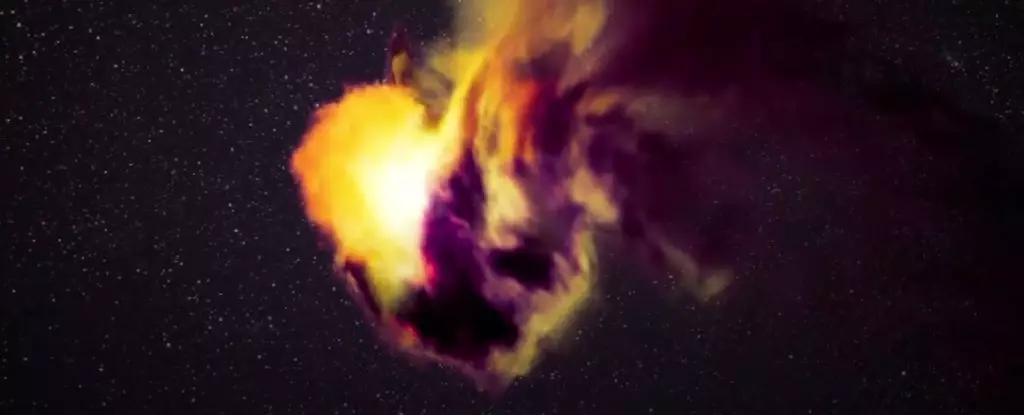The cosmos constantly reminds us of its profound mysteries, often challenging the very foundations of our astronomical understanding. The explosion of supernova SN2021yfj, observed in 2021, is one such remarkable event that has sent ripples through the scientific community. This distant stellar death, located 2.2 billion light-years away, defies conventional models by revealing elements and structures previously thought impossible in supernovae. Its unique composition has compelled astrophysicists to reconsider existing theories about stellar life cycles and collapse mechanisms, shining a spotlight on the complex and unpredictable nature of cosmic evolution.
A Stellar Death Like No Other
Traditional models have long depicted supernovae as spectacular but predictable finales for massive stars, characterized predominantly by the ejection of lighter elements such as hydrogen, helium, carbon, and oxygen. These elements, arranged in onion-like layers within the star, are expelled during the explosive death throes. Heavier elements like silicon, sulfur, and argon were believed to be confined deep within, only detectable under specific circumstances. Yet SN2021yfj shattered this paradigm — it showcased an unprecedented abundance of these heavy elements, suggesting it was the final chapter in a very different kind of stellar story.
What makes SN2021yfj particularly compelling is the evidence of a star that seems to have been stripped down to its core, devoid of much of its outer material before explosion. This “naked core” witnessed in real-time provides a rare glimpse into the internal structure of a dying star, one that has apparently undergone severe mass loss, challenging the idea that stars must retain their outer layers until the climax of supernova.
Challenging Long-Held Theories: Concentric Shells and Stellar Layers
For decades, astrophysicists have relied on the onion model—a layered structure of a star gradually fused from light to heavy elements. This model is rooted in the understanding that stars synthesize elements in concentric shells, with iron sitting at the core. When a star exhausts its fuel, it’s supposed to collapse inward, leading to a supernova that mostly reveals lighter elements on its outward ejected material.
SN2021yfj, however, suggests this picture is incomplete. The presence of significant silicon, sulfur, and argon in the ejecta indicates the star’s inner layers were exposed and ejected in an explosively turbulent prelude to the final supernova. It seems that this star experienced intense violent episodes close to the end of its life, stripping away much of its outer envelope through repeated eruptions. These upheavals created a complex environment, vastly different from the relatively calm, layered attributions of traditional models.
This discovery implies a more chaotic pathway for massive star evolution, where internal processes and mass loss are not as neatly structured as once thought. The notion that stars grow stable onion-like shells until demise is now in question, replaced by a narrative of violent shedding and tumultuous internal dynamics.
Unraveling the Turbulent Final Moments
The phenomenon driving this extraordinary supernova involves a star’s core losing fuel and triggering intense inward pressure, creating conditions ripe for explosive reactions. As the core contracts, the resultant heat reignites fusion in sporadic bursts, throwing off vast amounts of material into space — effectively peeling the star like an onion, but in a far more violent manner.
Multiple eruptions over a relatively short timescale could create a dense shell of ejected matter surrounding the star. When the final supernova occurs, its shockwaves collide with this shell at high velocity, producing the intense brightness observed across billions of light-years. This process resembles cosmic chaos—a star violently shedding its layers so thoroughly that when the ultimate explosion occurs, it resembles an inward-pushing rebellion against predictable stellar death models.
But crucially, this does not seem to be an isolated incident. If such pathways are viable, then the universe might host a spectrum of stellar endgames far more diverse than what current models predict. That possibility alone urges a fundamental re-evaluation of how stars die, how elements are distributed across galaxies, and how cosmic chemical enrichment occurs.
A Call for Deeper Inquiry and Broader Perspectives
While SN2021yfj provides tantalizing hints, it remains a solitary example—an intriguing anomaly that demands further investigation. The current theories, based largely on a limited sample size, must be expanded to include the chaotic and potentially violent histories leading to such explosions.
Astrophysicists are right to approach these findings with both excitement and caution. The notion that stars can be essentially “stripped to the bone” before going supernova highlights how much we have yet to understand about stellar physics. It underscores the importance of developing more comprehensive models that account for the myriad ways stars can evolve and die.
This event invites us to reimagine stellar aging—not as a slow, predictable process, but as a tumultuous journey fraught with violent episodes and unpredictable pathways. It also demonstrates that the universe’s complexity far exceeds our current grasp—a reminder that our scientific theories, no matter how refined, are often provisional, awaiting revision in the face of new data.
By critically examining such extraordinary cosmic events, we are encouraged to expand our perspective, embrace uncertainties, and acknowledge that the cosmos is far stranger and more intricate than any textbook can portray. SN2021yfj may be just a single supernova, but its implications ripple across astrophysics, deepening our appreciation of the universe’s raw dynamism.


Leave a Reply